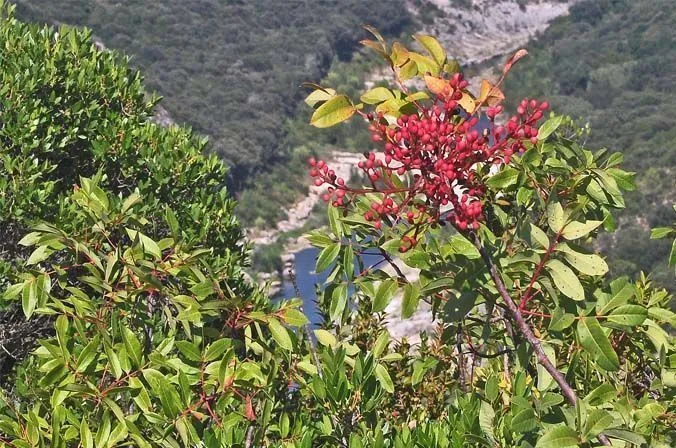Table of Contents
Scientific and vulgar name
Pistacia terebinthus. It is commonly known as cornicabra, descuernacabras, jedisco, cabricuerno or terebinto.
Cultivation area and climatology
It is typical of the Mediterranean area, especially the western part. It is common to see it grow in countries or areas such as the Iberian Peninsula, Morocco, Canary Islands, Greece, Italy or Turkey.
What is Pistacia terebinthus like?

It is botanically classified as a bush. It can grow up to 6 meters high. Very branched, little thickness and bark of the gray trunk. Young branches and reddish petioles (as seen in the photo above).
Family: anacardiaceae.
Cornicabra culture
It is typical of the Mediterranean area, where it grows spontaneously. It inhabits scree such as cliffs near the coast, calcareous soils (with alkaline pH) and sunny areas (total exposure to the Sun), although it also supports shaded areas.
Temperature: typical of Mediterranean area. Mild winters and hot summers. Withstands high temperatures. Medium resistance to cold and tolerant of temperature changes.
Flowering: from April to June (spring – summer).
fruiting: from October to November (autumn). Of the plant interest (for the medicinal properties) the leaves, the fruits and the bark.
Water needs: lives without the need for water, except rain) and is a plant that indicates soil dryness.
Resistant to salinity: suitable for cultivation in coastal areas.
Medicinal uses
- Antispasmodic
- Expectorant
- Antineoplastic: prevents the development of tumor cells
- Antiseptic
- Disinfectant: used as a mouthwash to strengthen the gums.
Maceration of the fruits: the fruits (30 grams per liter of wine) are macerated for a week and a half. After this time and according to the solid-liquid state of the mixture, it is strained or filtered. This mixture can be used for searchable rinses, strengthening the gums and as an antiseptic.
Nutritional content of the fruits
- Oleic acid (52.3%)
- Palmitic acid (21.3%)
- Linoleic acid (19.7%)
- Content of Na, K, P, Ca, Fe, Mg, Zn, Cu, Mn, Li, Ni, Pb, S, Se, Cd, Co, Cr, Sr, Ti, V, Ag, Al, As, B, Ba and Bi.
Organoleptic characteristics: sweet taste. The green fruits can be macerated and serve as a seasoning in appetizers (such as almonds, pistachios, etc.). In Cyprus, bread is made from its fruits. A liqueur is made in Crete (tsikoudia).
Trials and research with Pistacia terebinthus
- Antioxidant activity of Pistacia terebinthus for its content in flavonoids, β-carotene, DPPH, apigenin, luteolin, etc.
- Production of biodiesel from Pistacia Terebinthus.
- Characteristics of fruits and oil of Terebinto
- Fungicidal activity of the leaves of the cornicabra.
